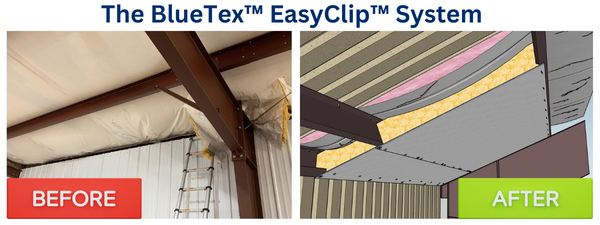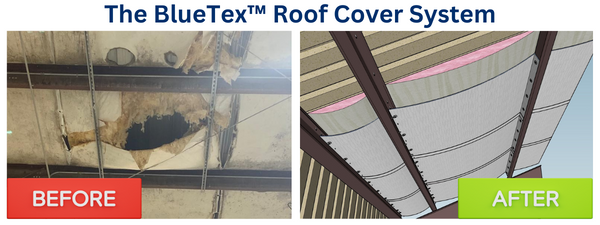How to Install BlueTex™ Between Old Insulation and Existing Metal Girts/Purlins
Note: This method involves removing the screws from the outside of the building.
If you're looking to cover old insulation from the inside of the building, without removing exterior wall screws, you can find that installation info here.
Use this install method to do a partial wall refinish (select sections) or the full wall. If doing the full wall, the top screws (near the roof edge) are NOT removed from the outside. They are usually “hidden” by either trim or gutters.

Supplies Needed:
-
BlueTex™ Pro 2mm 50" wide insulation
-
BlueTex™ 3" wide white vapor barrier seam tape
- BlueTex™ 48" wide aluminum term bars (screws included) or some other bar to hold the insulation against the girts (wood is a good alternative)

Covering up the ENTIRE WALL
If you're doing the full wall, you will cover from the ground to roofline in one piece.
Step 1: Measure the wall/section height & add 6" to it.
- If your insulation has areas where it's fallen off or is missing, take the time to fill in these areas with some batt insulation so the thickness of the wall is uniform.
- Measure your wall height + 6" and cut this off your Pro 2mm roll.
- Gather your aluminum term bars (or other material you're using) and your drill.
Step 2: Remove a section of exterior screws & anchor your bottom piece.
- Begin by removing the screw panels from outside for the section you are working on.
- Pull the BlueTex™ PRO from the ground upward, guiding it between the old insulation and the girts/purlin(s) continuing until you get to the top girt/purlin on the wall.
- Let the top piece of BlueTex™ hang in place while you secure your floor piece.
- Go back to the ground and prepare to attach the bottom of the BlueTex™ to the ground/bottom of the wall using one of the three options below to connect it to the floor/L-bracket. Our recommendation is to do Option 3.
Option #1 - Tuck BlueTex™ insulation between the old insulation and L bracket.
You might have to cut the facing if your original insulation was taped to the L-bracket.
-
- Cut BlueTex™ straight for bottom edge.
- Use drywall taping knife or 6” putty knife to push BlueTex™ in between the old insulation and your L-bracket.
- Re-use screws from outside to girts to secure; the screws should line up.
- OPTIONAL: Use a thin piece of metal or something like a coat hanger to line up the screw holes if needed. Push from outside and get help putting through original holes. Once one is in, the rest should line up easily.
- Cut BlueTex™ straight for bottom edge.
Option #2 - Push BlueTex™ insulation ON TO existing screws through the floor L-bracket.
-
- If you have screws coming through the L-brackets you should be able to use our insulation washers and push on to secure.
- A ½" deep socket works great and use either a hammer to tap on or if you have a hammer drill with hammer only or chisel mode works great to push it on.
- If you have screws coming through the L-brackets you should be able to use our insulation washers and push on to secure.
Option #3 - Screw BlueTex™ insulation into metal panel rib cavities.
-
- This is similar to the push on screw method except you use our ¾" self-drilling screws and insulation washers to secure the BlueTex™ to the bottom L-bracket. With this method you do NOT undo the exterior metal screws on the bottom L-bracket, you only undo the screws in the middle purlins.
- The KEY here is you can only put the screws where the ribs are in your panel. Otherwise, the screws will penetrate the exterior metal.
- Depending on your metal panel type the ribs are usually 9-12 inches apart. The good thing is they are very consistent, so double check the center to center rib distance on the outside of building.
- Cut into the old insulation to find a rib, or use a screwdriver to poke through the insulation and find the center of a rib. Then, you can precisely make marks on the L-bracket (or ground) for where the screws will go.
- This is similar to the push on screw method except you use our ¾" self-drilling screws and insulation washers to secure the BlueTex™ to the bottom L-bracket. With this method you do NOT undo the exterior metal screws on the bottom L-bracket, you only undo the screws in the middle purlins.
Step 3: Pull your BlueTex™ tight and secure the top portion.
-
Once the BlueTex™ is secured to the bottom L-bracket at the floor level, go to the top of the wall and push upward on the "tab" at the top EAVE STRUT. This will make the BlueTex™ smooth and tight. BE SURE IT IS STRAIGHT UP/DOWN.

-
Then use our aluminum term bar and screws (or a wood strip) to secure the BlueTex™ to the bottom of the top eave strut In the CENTER ONLY.
If you go with wood strips, we recommend preparing several pieces of wood at a time by pre-drilling 1/8" holes through the wood to prevent splitting. Then, pre-load your screws into the pre-drilled holes so you're ready to go. -
Have a helper pull the edges upward to make sure BlueTex™ is smooth and tight as you secure the term bar and cinch the insulation behind it.
Step 4: Replace the exterior screws and seal your seams.
- Replace screws from outside to cinch/lock BlueTex™ between your metal panel and wall girts/purlins.
- Finish the wall by taping all your seams with our 3" wide seam tape.

Covering The Bottom Partial Wall Only
If you're only doing the lowest section of the walls, between the ground and the first purlin, follow these instructions:
-
Start with the BlueTex™ roll on the ground and pull the piece up and between the old insulation and purlin, overlapping by at least 3”.
-
Continue upward, past the actual purlin about 6” so you have a tab you can pull later, to tighten the BlueTex™.
- At this point, the BlueTex™ should be straight up/down with about 6” sticking past the top of the purlin. Secure bottom of BlueTex™ to floor L-bracket. SEE Bottom/Floor Connection Methods in Step 2 above.
-
Next, you will want to pull upward on the BlueTex™ with moderate pressure to make it smooth and taut/tight. Once it’s tight, reuse the screws from the outside in existing holes through the metal skin, through the BlueTex™ Insulation and into the purlin.
-
Fold the BlueTex™ down on the purlin and use the purlin as a cutting board to trim off excess insulation.

-
Tape the seams with BlueTex™ 3” white vapor barrier seam tape. Tips for the best seaming:
- It’s best to have at least two people sealing the seams.
- Pre-cut the length of tape needed, keeping the tape flat.
- Have one person hold the top and press down the seam while the other person pulls the tape tight and holds about 12"-18" inches away.
- Continue until the seam is covered and tight.







